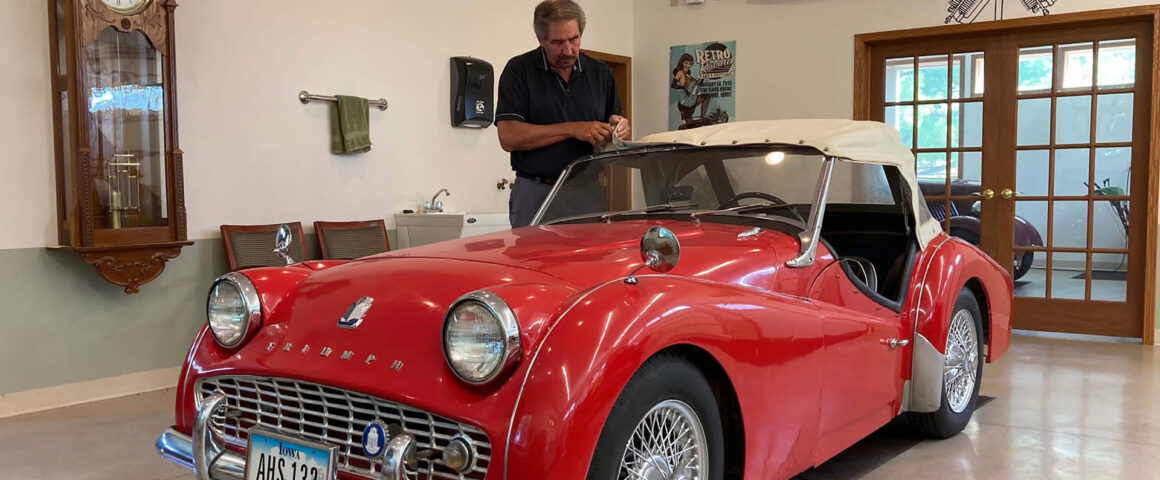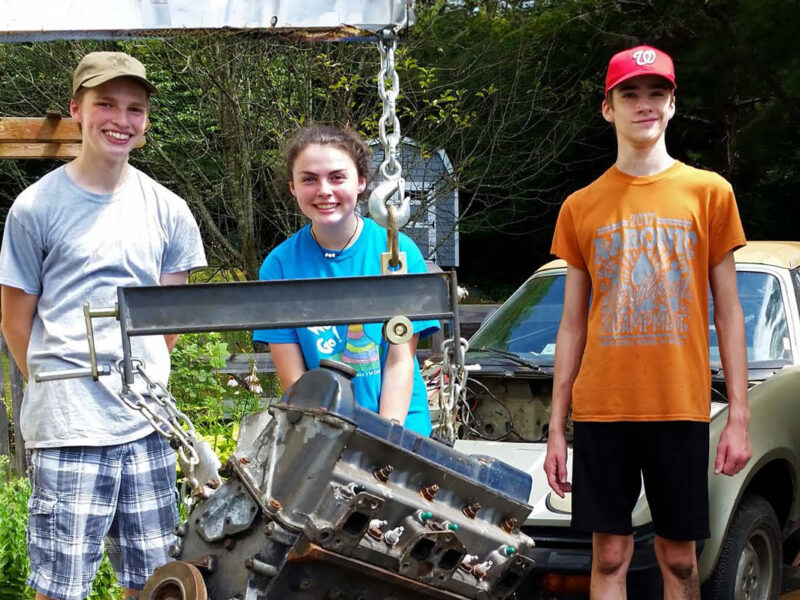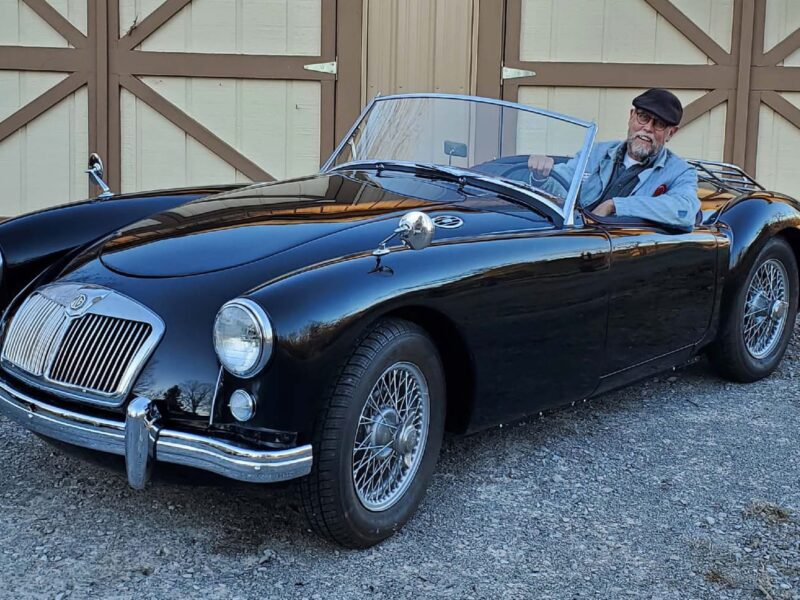By Jerry Reisinger
There it sat, covered in pigeon poop. A pregnant sow rubbed her back against the left front fender, rocking the whole car as I walked through the barn door. The engine was partially disassembled and the timing chain, chain cover, a wooden handled screwdriver, and a couple dirty wrenches lay on the dirt floor, under the car and out of reach of the hogs.
That was my first view of a 1963 TR3B that my father-in-law had said was in his brother’s barn, near Hampton, Iowa. The wooden barn was built in the early 1900s with a gambrel roof. There was a hay mow above, and animals below. The owner meant to make the repairs to the TR himself but then got distracted and the project languished. This was 1979 and the car had 39,000 miles on the clock. Not bad for an Iowa car that probably registered no miles between the months of October and April each year. Side curtains don’t cut it during a northern Iowa winter.
I had never seen a Triumph TR3 before, and I was clueless about this foreign auto. But its long front fenders and low-cut doors had style in spades. The black vinyl interior contrasted beautifully with its Signal Red body. The silver painted wire wheels added to its appeal. Four hundred and fifty dollars? I’ll take it.
The next day, we cobbled things together so we could flat-tow it with a chain behind the farm pickup to a friend of a friend’s shop nearby where he worked on large grain semi-trucks. Surely, if he could repair large diesel engines a simple little in-line four cylinder would be a piece of cake. North central Iowa has held on to strong rural Midwest traditions and I don’t remember ever seeing a foreign car dealer or repair shop in my days of growing up in Franklin County.
I agreed to steer the car while it was on the tow chain, which worked out well up until the unsecured hood blew up and lodged against the windshield. There’s just no good way to stick your head out the side to see what’s ahead, yell at the tow vehicle to slow down, and brake so as to not run into the pickup as it stops. This short trip was agony from start to finish, but we got there.
Amazingly, the truck repair shop got the engine working fine and I was able to drive the car to begin an amateur restoration. The mechanic and I discovered that a TR3B was different than a 3A in that the Triumph factory had the new engines and fully synchronized transmissions ready before the re-styled TR4 bodies. For only a few months the new TR4 engines and trannies were placed in the TR3As still coming off the assembly line and sold as 3Bs.
The previous owner had not abused the finish of the interior or exterior so the car looked immensely better with just a good clean-up. But you know how it goes; the more you look the more you see that everything needs attention. I found that in Iowa you can have rust even if your car wasn’t driven on salted road surfaces. This car had its share of rust.
My brother Spud, who owned a body shop, would come to my house on weekends throughout much of 1980 to help me with all the problems, no matter if they were body related or not. He’d take a couple panels home with him to work on in evenings, bring the straightened and primered panels back to my house the next weekend, and continue this process till it was time for paint.

Spud painted the car in my two-car garage hanging body panels on wires before spraying. Painting cars was still kind of archaic in 1980 and Spud was old-school, even for the times. It’s hard to say how much gasoline—which he used as paint thinner to clean the spray gun—he had discarded onto the ground.
There was no ventilation system in the garage, so we wet the floor with a garden hose to keep the dust settled. Water stood in a few shallow puddles where the floor wasn’t perfectly flat. This was a big day and Spud walked around, with no mask, spraying fresh red paint. When I looked in on him, I could only make out a faint silhouette of him in the dense red fog. He finally came out, slumped his Signal Red body onto a metal folding chair, lit a Marlboro with his trusty old Zippo, and grabbed an Old Milwaukee. Just another day at the office.
I relied on a copy of Triumph Owner’s Handbook of Maintenance and Repair, by Floyd Clymer, that came with the car. It had everything I needed concerning the details and repair instructions for engine, suspension, brakes, steering, carburetors, wiring, etc. I value the book so much that when it started falling apart I had it professionally recovered and bound.
When the car was finished, my family packed into it on nice evenings and weekends for short driving jaunts around northeast Iowa. Yes, the whole family. My two sons were in grade school and had fun cramming into the miniscule rear seat. My wife and I were comfortable up front, and I still can’t believe how much leg room there is. The car is exceptionally low and I’ve found that if I sit up like I should behind the steering wheel and lean only about one inch to my left I can touch the pavement with my fingernails.
The four of us would cruise along the Mississippi River stopping at small towns for ice cream, short hikes, lunch, and scenic vistas. The Pink Elephant Supper Club at Marquette, Iowa, was included in these stops. If there were bystanders where we parked they always had comments and questions. Some hung around longer just to see me get into the car.
The car has been in many parades and copious local events where someone needed an old classic car for one reason or another. The local high school students wanted it as a prop in their prom that had a New York, New York theme. The janitors weren’t real keen on it because of the potential for oil spots on the gym floor, which was taken care of by sliding a cut-up cardboard box under the engine.
Once my sons grew up, I found myself using the car less and less until there were years that I would drive it a few miles in the fall just to exercise it before being stored for winter. My sons are now in their forties and have children of their own. I left the TR3 at my son Pat’s farm about six years ago so he and his family could replicate our weekends while his sons were still small enough to fit in the car. Before long, Pat’s family grew too big for the TR3, and so I brought the car back to my property to do some of the things that were needed to the brakes, wiring, body, etc.
The original engine has never been overhauled and has been extremely consistent about starting and running right even if it wasn’t started the previous year. Just pump the gas peddle about four times, pull the choke cable out all the way, and hit the starter.
People ask me if I have trouble finding parts for the vintage car. I tell them that I could almost build a new TR3 from what’s available in Moss Motors’ catalogs.
My old TR3B is a good car but it is the life experiences and the people you meet with it that makes owning a classic car so much fun.
If you get a chance to buy one of the old British classic cars, go for it. They’re simple to work on. All body, interior, and mechanical parts are available and inexpensive and you’ll get your money’s worth of fun out of it. If you can get your family or dog talked into riding along, better yet!








'The Ride of a Lifetime' has no comments
Be the first to comment this post!